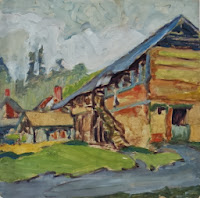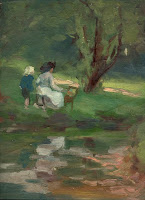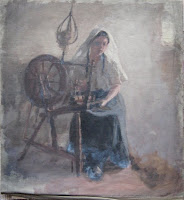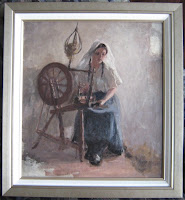 |
| Bertha M Ingle: Ships at harbour |
There’s a painting of Bertha’s that we believe we have come to
understand better in recent months. It’s a small sketch in oils that shows
ships at harbour. It has an unsettled and unsettling quality, its ambience
anything but calm.
Bertha grew up in Owen Sound, an important port city, and lived
most of her adult life in Toronto. She travelled to Vancouver and to Santa
Monica. She would have seen harbours and ships in many places. We’ve never been
certain where this painting comes from. But perhaps it can be pinned
down after all.
 |
| Bertha M Ingle: Roses |
 |
| F McGillivray Knowles: In Time of Peace, 1907 |
Bertha’s most influential teacher in Toronto was Farquhar
McGillivray Knowles, a prominent artist and member of Toronto Society. Bertha
studied at and became an Associate of his Studio, soon after arriving in
Toronto, and at various times she taught Art at places where he was Art
Director, such as the Westbourne School for Girls and the Ontario Ladies’
College. As an artist of considerable renown, McGillivray Knowles was (and
still is) well known for his interest and skills in representing ships and
marine subjects generally. An example is a large oil painting called In Time of Peace, 1907. It depicts battleships at harbour. The painting was exhibited in the 36th Annual Exhibition of the
Ontario Society Of Artists (OSA) in February - March 1908, from which it was
purchased by the Government of Ontario, in whose hands it still resides. According to the book The Ontario Collection by Fern Bayer, a published review of that Exhibition indicated the locale of In Time of Peace to be Quebec City.
 |
| F McGillivray Knowles: HMS Indomitable Leaving Quebec |
There’s another somewhat similar painting by McGillivray
Knowles, not quite as easy to find on-line, called HMS Indomitable leaving
Quebec. This one was reproduced in Maclean’s Magazine of September 1913 as
part of an article about Mr and Mrs Knowles and their Bloor Street West Studio
- an article kindly located for us by James F S Thomson, at the time we were taking
his excellent course at the University of Toronto's School of Continuing Studies (Toronto's Past: Your City, Your House, Your Family).
There are points of similarity between this Quebec painting and
Bertha’s sketch, we feel, such as the shape of the distant hills and the
general composition. They have caused us to wonder whether Bertha’s painting
might also come from Quebec. We know she visited there at least once, as a
member of a group of artists who were all painting and seeking commissions.
Just when was HMS Indomitable in Quebec, and why? Exploring
the answers to these questions has opened up new possibilities in our
speculations about Bertha’s travels. Most notably, HMS Indomitable made a
voyage to Quebec in July 1908, when she was brand new. She was commissioned for the trip in June 1908 ("before she was fully complete", according to the Wikipedia article). It was for a very special occasion
indeed, and she carried a very special passenger. She brought no less a
personage than the Prince of Wales (who in 1911 would become King George V) to
participate in the tercentenary celebration of Champlain's founding of Quebec
in 1608. The Prince was greeted by thousands of spectators in addition to the
formal welcoming party, when Indomitable steamed into the harbour on the
afternoon of 22 July.
This celebration was no intimate gathering, but a
multi-national gala on the grandest scale, an event unsurpassed in Canada till
Montreal’s Expo 67. England, France, and the United States of America each had
a major presence, and collectively they filled the St Lawrence River below the
City with an impressive array of warships and other craft. The elaborate
celebrations on land lasted two weeks, and included a large-scale
fully-costumed multi-act Pageant on land and water, comprising re-enactments of
Champlain’s arrival, key battles, and other notable events. People thronged to
Quebec in their thousands to see the spectacles. The three visiting nations,
former adversaries, somehow were able to collaborate and join forces
to honour the tricentennial in the most spectacular possible way. It was an
organizational and political tour de force, yet one which is little remembered
in the annals of this country's history. It is recalled and described in detail
in the fascinating book by H V Nelles, The Art of Nation-building: Pageantry and Spectacle at Quebec's Tercentenary.
Nelles writes that about a half-dozen Canadian painters were officially invited to come and record their impressions of the events. Mr McGillivray
Knowles might well have been one of them, and it would have been especially
fitting, since his mother had been born in Quebec. HMS Indomitable sailed
for home at first light on the morning of 29 July, after a week in port,
returning the Prince of Wales to England. It was that departure that Knowles
captured in his painting.
 |
| Postmark on Bertha's postcard |
Did Bertha paint her oil sketch at Quebec, at about that same
time? We have long believed that she went to Quebec in the summer of 1907.
Might she also have accompanied McGillivray Knowles and others the following
year, to attend this extravaganza of a lifetime? Might we be mistaken about
1907? We reviewed the evidence. Apart from family oral tradition, there is just
one dated document, a postcard with a photo of the Champlain Market, sent by
Bertha from Quebec to her family in Toronto. It says nothing of celebrations,
but it does clearly establish that she was there with a group of artists who
were trying to find work. The postmark date is 22 July, and the writing
includes the word ‘Monday’ as a sort of marginal note. The postmark year is
very faint and indistinct, unfortunately. It does look most like ’07, and 22
July 1907 was indeed a Monday.
Is it possible the card was sent in 1908? The date 22 July 1908
was a Wednesday (and the very day of the arrival of the Prince of Wales). We
think it unlikely that Bertha would wait two days, to post a card on Wednesday
that she had written on Monday, but it’s not impossible. And, tantalizingly,
there are spots of paint on the card that look as if they might be the same as
colours in the oil sketch.
 |
| Postmark from 1907 found on-line |
I decided to try searching the web for images of 1907 Quebec postmarks,
and somewhat to my surprise I found quite a few. Those that most closely
resemble the one on Bertha’s postcard strengthened the conclusion that the card
was from 1907, because the faint impression of what should be the downstroke of
the ‘7' is in exactly the right place. We wondered if another source of
corroboration might come from the Toronto address to which the card was mailed,
which was on Euclid Avenue. From the City of Toronto Directories (which were
published in January of each year), we determined that the Ingles were living
at Trinity Square at the start of 1907, but at Euclid Avenue by the start of
1908. A different postcard, mailed home by Bertha’s sister Ettie, confirms that
they were there on 5 August 1907. So the address doesn’t really settle the
issue conclusively; neither year can be ruled out on that basis.
I feel 1907 is the more likely date for our Quebec postcard. Bertha may have been there in 1908 as well. The two McGillivray Knowles paintings would appear to confirm that there were battleships present in both years. Whichever year it was, I believe that the sight disturbed her greatly, that she
did not see in those massive objects the majestic display of military might; she saw, instead, forces of destruction and
chaos. Her little sketch, I believe, expresses her revulsion, even anger.
One of the main events of the tercentenary celebration was a
formal presentation on The Plains of Abraham. A huge gathering of militiamen
and sailors from all the participating countries were assembled, as many as
fifteen thousand altogether. They watched the Prince of Wales present the title
deed to Governor-General Earl Grey, along with a large sum of money
contributed to by all four countries and the Empire, with the express
intent that the Plains be designated forever a 'shrine of union and peace' where 'two contending races won equal and imperishable glory'.
| Bertha M Ingle: The Plains of Abraham |
Bertha painted another picture that in family oral tradition
depicts The Plains of Abraham. If this is true, it may also reveal
something of her view of the mechanisms of combat, though in a very different
way than the painting of the battleships. There is something that could be a
cannon lying derelict and abandoned, off to one side, while domestic
life, washing hanging out to dry in ordinary back yards, has claimed the main
ground, upstage centre. A far less ostentatious way to portray union and peace,
but telling nonetheless.




sm.jpg)



























